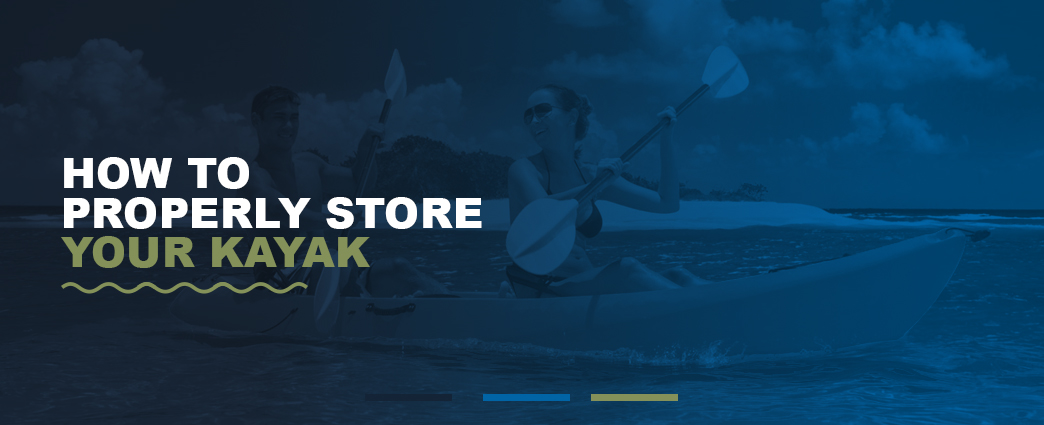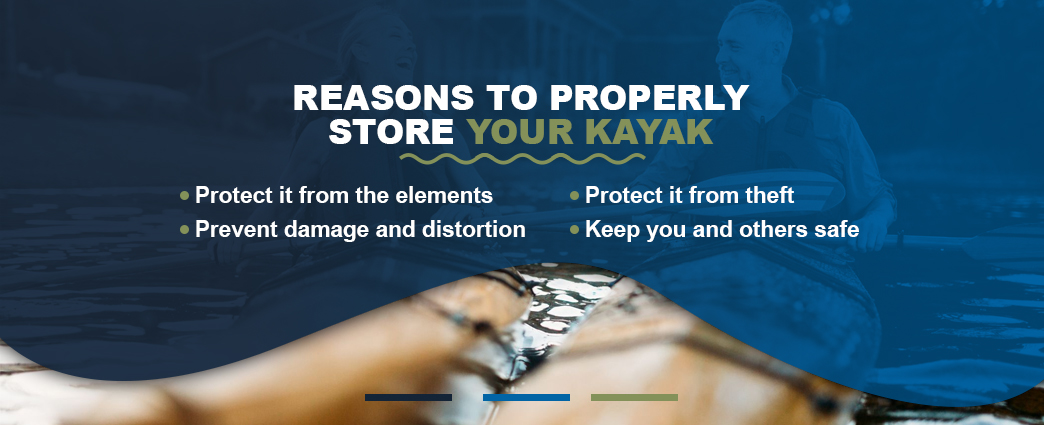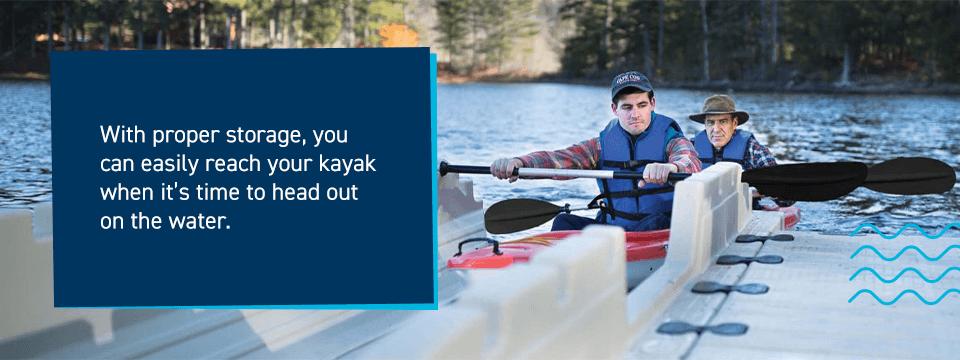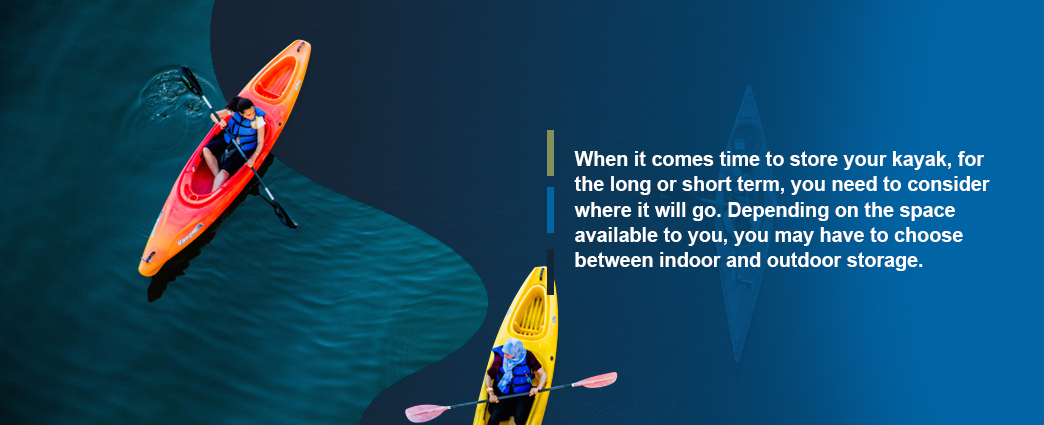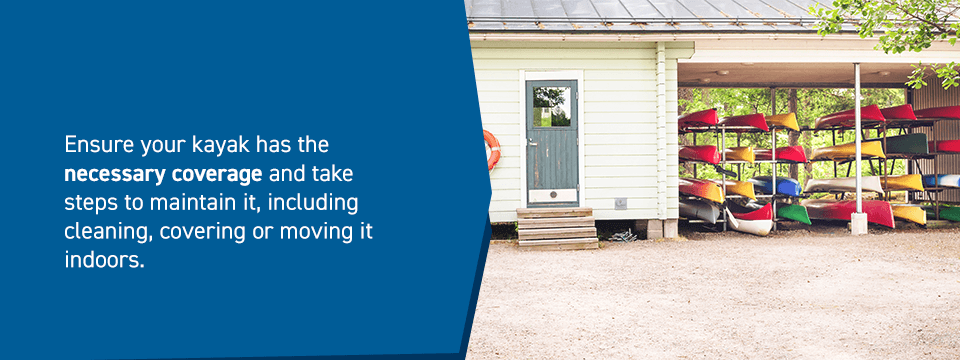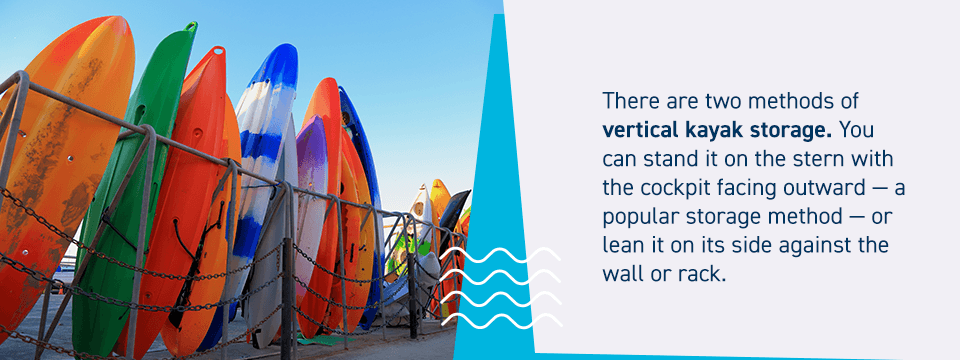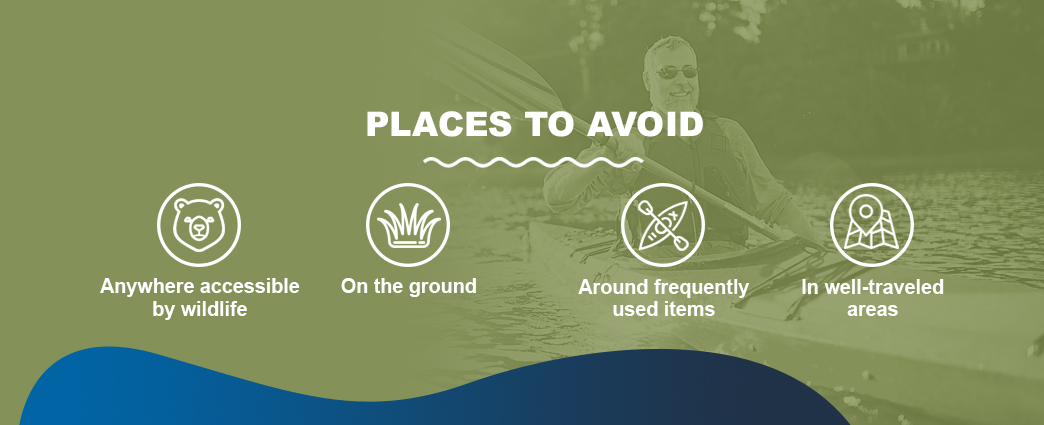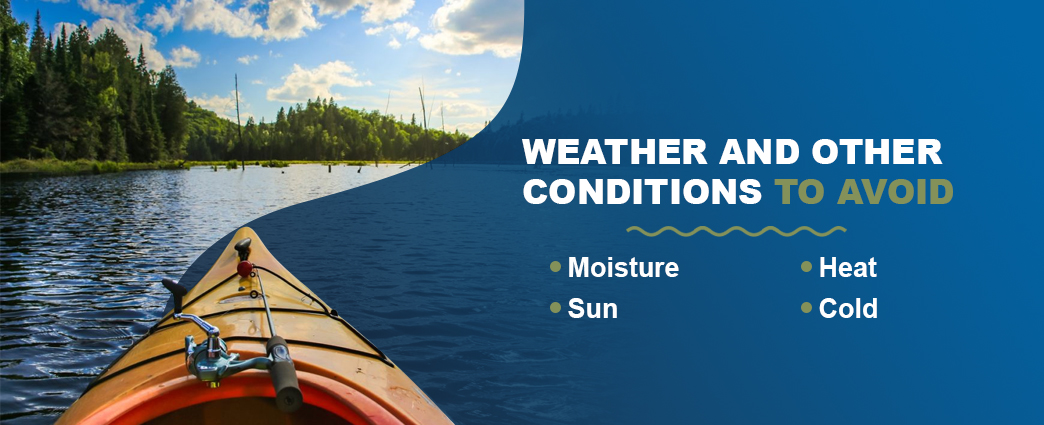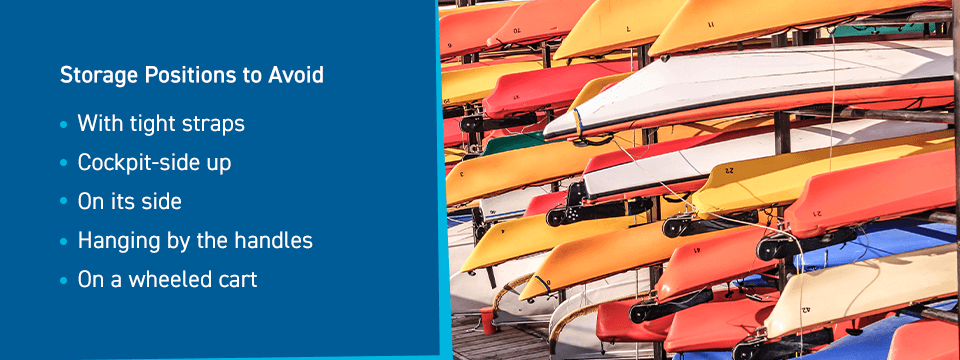Filters
How to Properly Store Your Kayak
Protect Your Kayak By Properly Storing it
As you finish up your adventures on the water or the kayaking season comes to an end, you’re left wondering how to store your kayak properly. Beginners to kayaking and seasoned experts alike can benefit from knowing how to store their kayaks. From the best way to store a kayak outdoors to other advice on storing your kayak in the long and short-term, the following tips will ensure you can use your kayak for many seasons to come.
Take care of the investment that is your kayak so you and your family aren’t disappointed by the sight of a damaged kayak once boating season rolls around. Follow the tips for storing kayaks below and learn the importance of proper care so you can enjoy your kayak in the coming years.
Read the full guide or jump to a specific section:
- Making Your Kayak Last Longer: Reasons to Properly Store Your Kayak
- Short-Term Kayak Storage Tips
- Long-Term Kayak Storage Tips
- Should I Store My Kayak Indoors or Outdoors?
- The Don’ts: How Not to Store a Kayak
- Additional Tips for Storing Kayaks
- Store Your Kayak With Our Help
Making Your Kayak Last Longer: Reasons to Properly Store Your Kayak
You love the freedom and adventure that comes with kayaking, so you should take steps to care for your kayak. Properly storing your kayak will help it last longer because it will:
- Protect it from the elements: Rain, snow and sun can all have an impact on your kayak. Store your kayak properly, and you’ll prevent damage, warping, fading and other issues that the weather can cause.
- Prevent damage and distortion: While the elements can damage your kayak, the way you store it can, too. Properly storing your kayak will prevent dents, distortion and other damage on its sides or bottom.
- Protect it from theft: You must also be sure to protect your kayak from theft. Proper storage in a locked area will keep your kayak safe and away from anyone who may want to take it.
- Keep you and others safe: If you were to hang a kayak incorrectly, whether on the ceiling, wall or another surface, you risk it falling on yourself or others. Even if you’re lucky enough that no one is near the kayak when it falls, it could be damaged as a result.
There are lots of good reasons to store your kayak properly. But how do you store a kayak? What are the best ways and places? Below you’ll find tips for an array of storage locations and methods that will help preserve your kayak through any season.
Short-Term Kayak Storage Tips
When your kayak won’t be hitting the water for a few days to a week or so, you’ll need to store it for the short term. Consider using short-term kayak storage for the following situations:
- Day-to-day use
- Going away on vacation
- Short periods of inclement weather
- Shorter off-season periods for those in mild climates
- Taking a break from kayaking for any reason
Even if you’re using your kayak from day-to-day, you still need to store it with care. Damage won’t necessarily happen overnight — unless your kayak falls from a wall or ceiling or another incident occurs — but repetitive incorrect storage could have an impact over time. You may also leave your kayak vulnerable to theft with short-term storage since you may not take extra care for a day or two of storage.
Not sure where to put a kayak for a few days or weeks? Depending on the climate where you live, you may be able to choose outdoor or indoor storage. Short-term storage is more flexible than long-term, but keep the following tips for proper storage in mind:
- Keep it accessible: Since you’re only storing your kayak in the short term, you don’t want to keep it somewhere that’s hard to reach. Ceiling or wall storage in areas with other objects in the way won’t be convenient when you want to take your kayak out on the water.
- Take the time to put it away carefully: When putting your kayak in short-term storage, you may not feel like taking the extra time to store it properly. Even if your kayak is only in storage for a week, you should still put in a bit of effort to keep it safe and protected from damage during that time.
- Lock it up: Keep your kayak protected from theft even if you’re only storing it overnight. Use a lock if you’re storing it outdoors or keep the indoor location locked and protected with alarms, cameras or other security tools.
With proper storage, you can easily reach your kayak when it’s time to head out on the water, and you’ll rest assured while off the water that your kayak is safe from theft and potential damage. Since you’ll be putting in effort for short-term storage, be sure to do the same for longer periods to ensure even more protection.
Long-Term Kayak Storage Tips
Short-term storage is manageable, but how do you store a kayak for the winter and other long periods? There are many types of kayaks out there, and depending on the kind you have, your long-term storage options may vary. An inflatable kayak, for example, is simple to pack away for storage in the winter. Simply deflate it and roll or fold it up to stay in a cool, dry place until the kayaking season is back.
For other varieties that aren’t foldable or collapsible, you need to consider how much space you have and how to store your kayak properly for the long term. When you get ready for kayak winter storage, make sure to:
- Figure out your space: With short-term storage, space may not be too much of an issue, but when you’re putting your kayak away for the months ahead, think carefully about where you’re putting it. You don’t want your kayak to be in the way of other items you need, and you definitely don’t want to store it in commonly used areas.
- Keep the kayak clean: Along with where to keep it, you need to know how to prepare your kayak to store, especially for long periods. The best way to maintain your kayak while it’s in storage is to clean it well before you put it away. Clean the outside and inside, then dry it thoroughly to avoid moisture build-up. Taking it out of storage will be easier with a cleaner kayak and you’ll be less likely to see the damage once storage season is over.
- Take similar steps to short-term storage: While your kayak won’t need to be accessible for everyday use, you’ll need to reach it easily at the start of the season. Store it with other seasonal items or make sure it’s out of the way yet relatively easy to access once warmer months roll around. You’ll also want to keep it protected from theft by locking the storage area and taking other security precautions.
Unless you live somewhere with a mild climate, you’ll need to keep your kayak out of the cold and snowy weather during the winter. Keep it in a climate-controlled area, which will be much easier if you store your kayak indoors, but you do have outdoor options in some cases.
Should I Store My Kayak Indoors or Outdoors?
When it’s time to store your kayak, consider where it will go in the long or short term. Depending on your available space, you may choose indoor or outdoor storage. Even if you don’t have a choice, you should know how to properly store your kayak indoors or outdoors, so it’s safe during the off-season and when not in use. The right solution depends on several factors, including the kayak’s size and weight, your budget and available space.
Indoor storage is ideal — it limits your kayak’s exposure to the elements and other potentially destructive forces. It’s not always practical, so it’s best to know how to store it in any condition.
Storing Your Kayak Outside
So, can you store kayaks outside? This option is best for in-season use. You don’t want to keep your kayak right in the water, but you don’t want it to be accessible during the season so you can head out on the water quickly. Dock attachments can keep your kayak off the water while allowing easy access during the on-season. Our EZ Launch® Residential, for example, makes it easier to embark and disembark your kayak.
As long as your kayak is off the water, you can store it outdoors for a short stretch of time. The best way of storing a kayak outdoors for a longer period is to keep it out of the water and under some sort of cover. For example, mounting racks on a wall keeps your kayaks off the ground and easily accessible for in-season use. Some other options for long-term outdoor storage include:
- Under a deck
- Under a roof or eaves
- On a covered porch
- With a water- and UV-resistant kayak cover
- Under a tarp, strung up if possible
If you live in a milder climate, you can store your kayak outdoors longer. Perform regular checks for moisture, weather damage and pests. Ensure your kayak has the necessary coverage and take steps to maintain it, including cleaning, covering or moving it indoors. For the best possible outdoor storage, you can:
- Create a shelter: Instead of wrapping, create a tent-like cover and store your kayak underneath. The tent shape allows water to drip off the tarp.
- Pest-proof the cockpit: Prevent rodents and other pests from getting in through the cockpit with specially designed wraps, and throw in some moisture-absorbing pellets before closing the cover.
- Remove fabrics: Store any fabric components indoors to prevent rodents and other pests from nesting inside.
- Keep your kayak off the ground: Find a special rack to elevate it so it gets plenty of air and moisture can’t get trapped underneath.
- Keep it secure: Hide your kayak from view and keep your chosen storage space inaccessible.
Storing Your Kayak Indoors
Indoor storage is your best option if you have the space. One of the best kayak storage locations is in the garage, but some kayakers choose a shed, basement or other storage areas. If you have a spare room, you could even house your kayak there until it’s time to hit the water. How do you store a kayak in the garage, shed or other indoor areas? Follow some of our top tips to store your kayak properly:
- Make sure you can control the temperature
- Keep the boat away from windows to prevent sun damage
- Don’t obstruct walking paths
- Find a space with controlled temperature and humidity
While keeping your kayak indoors is the safest choice to prevent damage and theft, make sure it isn’t getting in the way of your daily life, which could be inconvenient and even dangerous. You should hang your kayak correctly if you’re storing it on a wall or from the ceiling as an extra measure against damage to the kayak and injury to others.
How to Store a Kayak Vertically
Vertical kayak storage is best for short-term safekeeping, security and saving space. You can use indoor or outdoor vertical storage, though if you plan to store your kayak vertically for long periods, it’s better to do so inside. Rest the boost against a wall with the cockpit facing outward. To ensure the kayak stays standing, position it at a slight angle. Set the kayak so the bow is in the air and the stern is on the ground.
Depending on your living situation, space is precious and you need to make the most of what you have. If you need to store your kayak in your home, vertical options will give you more space to explore. Vertical storage also helps to keep your kayak secure, as there is less chance of it being knocked over or bumped around.
The stern of a kayak is typically wider than the bow, making the backend of the kayak a bit heavier than the front. The wideness and weight will create a more stable base for the kayak to stand on than the narrow bow. If you’re storing your kayak vertically, be sure to follow these tips to ensure proper kayak storage:
- Use padding: Similar to how hanging your kayak by its handles can strain the ends of the kayak, the stern will be susceptible to some pressure and strain as it holds up the boat’s weight. To help ease any strain, you should use padding under the stern. Towels or cushions will work fine, though some manufacturers have their own padding. Placing your padding in a crate provides added stability and a perfect place to position the stern.
- Secure with pegs: Another common concern is how to stabilize the kayak’s bow so it won’t slide down the wall. The best way to keep the kayak from falling is to install support pegs on either side of the bow. The pegs will hold the kayak if the bow starts to lean or gets bumped.
- Use a rack: You may also want to look into racks for storing your kayak vertically. Ceiling-mounted kayak racks ensure proper stability and often feature a chain or rope to hold your boat in place. If you’re handy or enjoy DIY projects, consider making your own vertical storage rack.
- Cover the cockpit: If you’re temporarily using vertical storage outdoors, you should consider covering the cockpit. Doing so helps prevent moisture, pests, leaves and other debris from collecting in your cockpit. Even if you’re only storing your kayak in this position for a day or two, you’ll have a much easier time getting back on the water if your cockpit is free of debris.
- Choose the best location: Ensure your choice of location keeps your kayak out of the way and safe from direct sunlight.
Vertical kayak storage is a great option if you don’t have a lot of horizontal storage space. Just be sure your kayak is secure to prevent it from falling over and try to limit this storage method to short-term use. Keep the location as safe as possible and find a space where you can regulate the temperature. Keep these tips in mind, and you’ll have an accessible way to store your kayak and save space.
How to Hang up a Kayak for Long-Term Storage
When the kayaking season ends, you need a place to keep your kayak on a more long-term basis. Hanging your kayak from the ceiling is an excellent alternative for keeping it dry and out of the way. Most vertical hanging systems consist of two pulleys, rope length and straps to support the hull. You can buy specialized kayak suspension systems or make your own with wide webbing straps. Consider these tips for how to hang a kayak:
- Avoid the boat loops: Hanging your kayak by the boat loops can bend the boat. Your straps should encircle the body of the boat.
- Keep security in mind: It’s worth locking your kayak up with a chain, long cable or gear lock in the hull.
- Choose the best hoist system: Choose whether you prefer manual hanging systems or electrical hoists, depending on your preferences and budget.
- Ceiling safety: Ensure your straps and pulleys are attached to the ceiling with safety in mind. Install your system into the ceiling studs to prevent your kayak from falling.
If you bear these tips in mind, hanging your kayak can be an excellent storage method that provides you with the extra space you need during the off-season.
The Don’ts: How Not to Store a Kayak
Storing a kayak properly is one thing, but it’s helpful to know how not to store one, as well. Here are places, conditions and methods to avoid when storing your kayak.
Places to Avoid Storing Your Kayak
Short-term or long-term, indoors or outdoors, there are practices to avoid when storing your kayak. Keep your kayak away from the following:
- Anywhere accessible by wildlife: Small animals may love to make a home in your kayak’s cockpit. Don’t give pests the chance to hide out in your boat and give you a shock when on-season comes again. Store your kayak indoors or cover it properly so animals won’t make themselves at home in it.
- On the ground: Ensure your kayak is elevated, especially if you’re storing it outdoors. Contact with the ground could cause damage due to moisture or freezing temperatures. Hang your kayak or cover the ground with waterproof and weather-resistant tarps or other materials.
- Around frequently used items: Remember, whether you suspend your kayak from the ceiling or hang it on the wall, you don’t want it getting in the way of other items you use. You risk knocking the kayak down, causing damage or injury, as you try to reach behind or around it to get to something else you need.
- In well-traveled areas: Walls or low ceilings where you or others walk by often won’t make a great storage option for your kayak. It could be unsafe for passersby or inconvenient to you and your household.
- On hard, flat surfaces: The ground isn’t the only hard surface you need to remember — any hard, flat surface results in uneven weight distribution and extra pressure on specific contact points. They can distort the hull in a few days and could result in damage.
- With an uncovered cockpit: All sorts of pests might see an uncovered cockpit as an invitation to move in. Over time, they can cause permanent damage.
- Without proper locks: Leaving your kayak unlocked makes it easy prey for thieves. Invest in adequate locks to protect your investment and your hobby.
- In an inaccessible location: You want to be able to check your kayak regularly for signs of damage. If you store it somewhere you can’t access, you won’t be able to catch signs of damage early enough to fix it.
Weather and Other Conditions to Avoid
Even if you store your kayak inside, you must make sure the indoor storage doesn’t expose your kayak to:
- Moisture: Just because your kayak is suitable for use on the water doesn’t mean it can sit in storage with it. Whether you live in a humid climate or you have moisture in areas you plan to keep your kayak, take steps to avoid moisture damage. Use a dehumidifier or choose spaces that aren’t at risk for exposure to rain and humidity. Moisture build-up can cause warping or provide an environment for mold and fungus growth.
- Sun: UV rays from the sun can cause fading, but even worse, sunlight can cause damage to certain kayak materials with prolonged exposure. If possible, keep your kayak away from the sun. Window coverings are your next best option if you can’t avoid sunlight exposure.
- Heat: Extreme heat can cause your kayak to become distorted. Keep kayaks away from heating units during colder months and keep storage areas climate-controlled during hotter months for the perfect balance.
- Cold: Out of all elements, cold is the least concerning. Still, you’ll want to keep your kayak in a climate-controlled area during the cold months to avoid continuous freezing and thawing, which can cause damage. Ensure the area you’re storing your boat in is above 32 degrees Fahrenheit to prevent the potential for freezing.
Storage Positions to Avoid
The way you position your kayak when storing it has a significant impact on its condition. Be sure to avoid storing your kayak:
- With tight straps: Don’t make the mistake of strapping your kayak up as tight as you would for traveling. While tight straps when traveling prevent accidents and damage, keeping the straps tight for more extended periods will put excess pressure on the hull and damage your kayak.
- Cockpit-side up: When you place your kayak on storage bars this way, it could dent the bottom. So how do you store a sit-on-top kayak or similar models? Store your kayak upside down to avoid unnecessary dents.
- On its side: Again, when storing a kayak on storage bars, be careful which way you orient it. Storing your kayak upside down is the most risk-averse option, as resting it on its side can dent whichever side has direct contact with the bars.
- Hanging by the handles: If you hang your kayak by the handles on the front and back, you’ll put strain on the ends. The kayak may deform and bend at the ends if hung by its handles.
- On a wheeled cart: Only use carts with wheels for transporting your kayak. When it’s time to store the boat, keep the cart somewhere else. A wheeled cart could put pressure on the opposite end. It also creates an unsafe situation because the kayak could roll into someone or something.
Additional Tips for Storing Kayaks
The above advice will help keep your kayak safe from theft and damage throughout the storage season or day-to-day use. If you’re still concerned about proper care, we’ve got a few additional tips in the form of frequently asked questions that will help. Some commonly asked questions by kayak owners include:
- Can I store my kayak vertically? You can store your kayak on one side or vertically on one end, but it’s best to do this only for a day at a time. Any longer, you risk damaging or deforming the body as it lays on one side for too long. Especially with vertical storage, the kayak’s weight will put pressure on itself and may distort the end of the boat resting on the ground or other surfaces.
- Do I need a kayak rack? Whether you opt for indoor or outdoor storage, you’ll want a way to keep your kayak off the ground or floor. In that case, you may need a kayak storage rack or another way to hang your boat. You can choose racks that have padding to lessen the impact of pressure points. If you use ceiling storage, you can opt for a rig with straps instead of bars. These storage systems usually have a lower profile.
- Where do I store a kayak in an apartment? If you live in an apartment and want a kayak, choose an inflatable or collapsible option for easy storage. There’s still hope if you’ve already invested in a non-collapsible kayak. You could hang it on the wall of your apartment if you have room — and family members or roommates who wouldn’t mind — but a more convenient option may be to look into storage rentals or keep it outside for the short term.
- What do I do with the accessories? Just as you want to take the right steps to store your kayak, you should do the same for its accessories. You should clean your paddle, bilge pump and other equipment before storage, ensuring everything is dry.
- How can I keep my kayak safe when storing it? Your kayak isn’t the only thing you need to think about — Kayaks are heavy, and if one were to fall, it could cause damage. Avoid making kayak storage a safety hazard by keeping it secure and using reliable suspension methods.
- Do I need to clean my kayak before storage? Yes, without a doubt. Give your kayak a thorough clean and remove all moisture before you store it.
- What else should I do before I store my kayak? It’s tempting to leave fixing any broken parts until the next time you use your kayak. Chances are, you’ll forget about whatever maintenance you need to do, which can be frustrating when you get your kayak out again. You’d have to complete your maintenance tasks before you hit the water. Instead, take care of any repairs at the beginning of your storage cycle.
- Can I put my kayak in storage at a facility? Yes, as long as the storage facility is secure and protects your kayak from the elements. Check your kayak whenever you’re in the area and keep your eyes open for signs of damage or lack of security.
Store Your Kayak With Our Help
If you need day-to-day storage during the boating season, our EZ Launch® Residential is for you. Beginners and experts alike love the accessibility this dock launch provides. You can easily get in and out of your kayak all above the water, meaning you can even kayak during cooler seasons without getting wet. Launch with confidence on this dock that provides stability, and return with ease thanks to the built-in paddle notches, V-shaped entry centers and its ability to move as the water level changes.
The EZ Launch® Residential system connects seamlessly with standard docks or our dock sections. You’ll get a durable and slip-resistant surface with our dock sections, and with the addition of a kayak/canoe launch, you won’t be left wondering where to put your kayak during the boating season. Discover our EZ Launch® Residential and request a quote today to add convenience and durability to your kayaking season.

